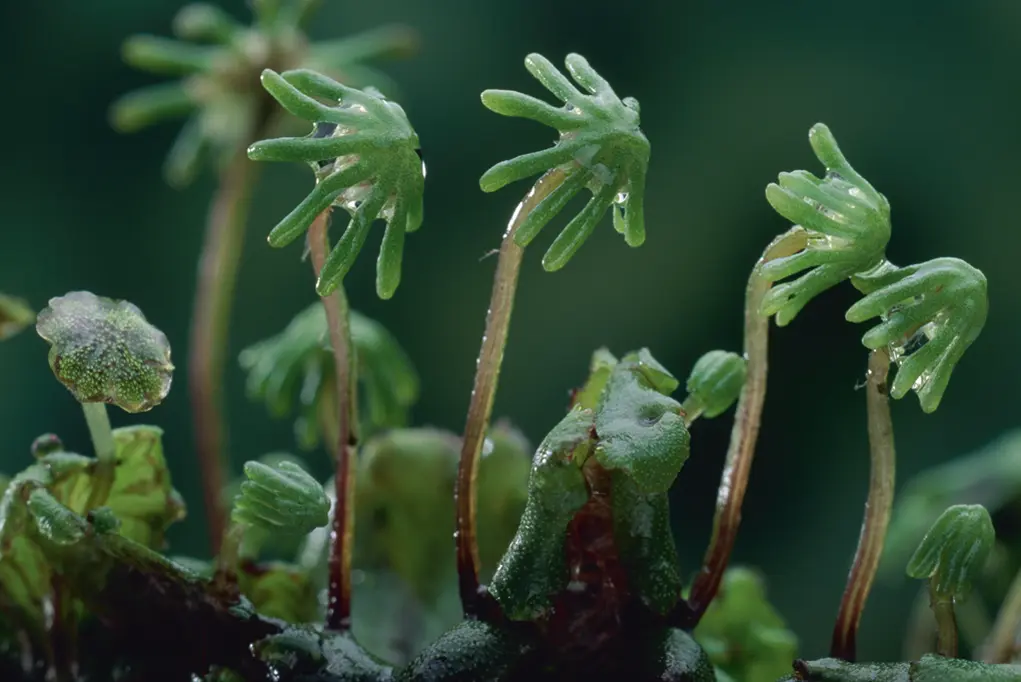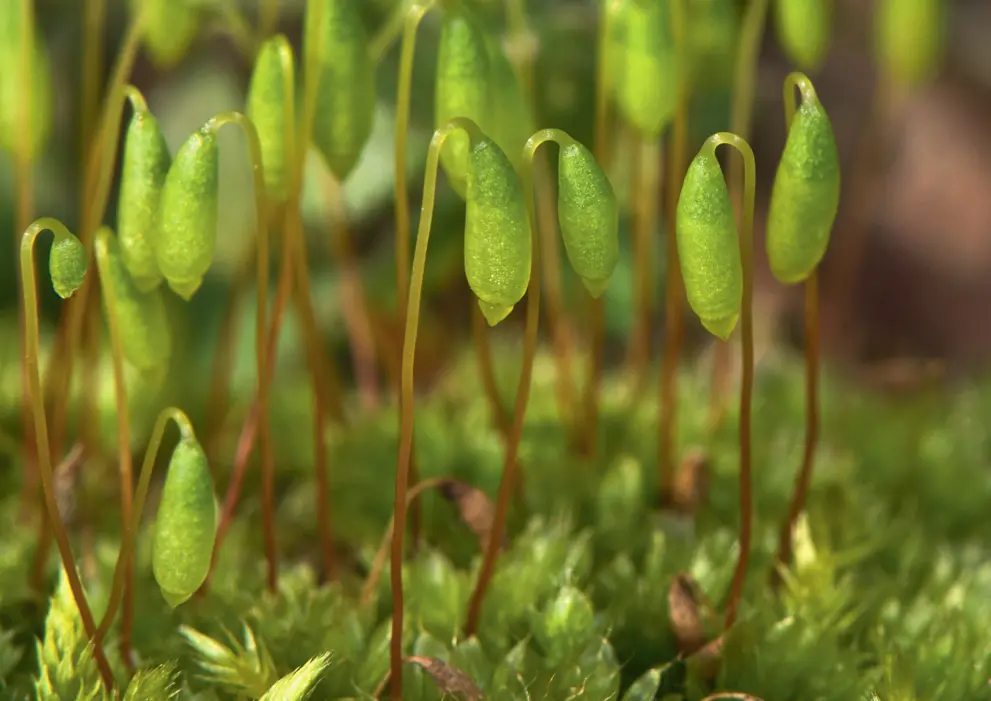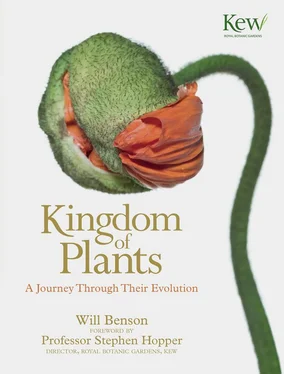From the point, two billion years ago, at which cyanobacteria first began to produce significant amounts of oxygen by photosynthesis, it still took a further billion years for the levels of oxygen to reach even half of what they are today. Around 1.6 billion years ago, during the mid-Proterozoic eon, oxygen had risen to comprise about 10 per cent of the Earth’s atmosphere, and by now the cyanobacteria had been joined by a host of varied photosynthesising life. These were the red algae, brown algae and green algae, and for the next 500 million years the soft and slimy, filamentous bodies of these organisms thrived in the oceans of the prehistoric world. As these algae evolved, they increased in complexity, developing advantageous new adaptations. Some developed multiple and specialised cells, allowing them to absorb nutrients and sunlight more effectively, and by dividing labour to different cells their growth and reproduction became more streamlined. Coupled with this, the various different algae packaged their genetic material into a single central nucleus, which distinctly separated them from earlier photosynthetic life. Unlike the cyanobacteria before them, these algae were among the first eukaryotic life forms, made of the type of complex cells that make up all higher life on Earth today. Most importantly, their light-absorbing chlorophyll pigments became stacked and enclosed within a double cell membrane, creating the self-contained photosynthetic structures we know from plants on Earth today. These are called plastids, or when in green algae and plants, chloroplasts. These relatively basic but increasingly ingenious organisms, although still confined to their aquatic habitat, first began to embody what we now recognise as the first plant life on Earth.
The vast colonies of red algae (whose colours actually ranged from green to red to purple to greenish black) stretched across the ocean floor, where they absorbed the shorter wavelengths of light that penetrated the murky depths. Brown algae soon became adapted to rocky coasts, attaching themselves to submerged rocks by structures called holdfasts. Crucially, green algae acquired an advantage that enabled them to thrive in the shallow waters of land formations. Unlike most other algae, green algae (known as Charophyceae) are able to survive, and even flourish, in the strong light of exposed shallows. There are very few fossilised remains of the marine algae of this time, as their bodies were soft and easily broken down when they died. The exact stages that they underwent as they moved closer to land are unknown. However, we can deduce that around 500 million years ago green algae from the marine habitats and freshwater lakes washed ashore and became stranded on land. Some of these would have given rise to the first land plants. The earliest trace of plants on land that is recorded in the geological record is of the reproductive spores of a plant from the Ordovician period, some 470 million years ago. Analysis of these spores has revealed tiny structures which resemble those seen in a type of modern-day primitive plant called a liverwort.
The Palaeozoic era, which literally means the age of ‘ancient life’, stretched from 543 million years ago to 251 million years ago. From this time onwards scientists have been able to trace individual groups of early life. Around 500 million years ago, in a period within the Palaeozoic called the Cambrian, oxygen levels in the oceans dropped drastically, causing a condition called anoxia, which soon spread across the planet. This may have been the trigger for algae to move from water to land. Many of the free-floating, bottom-dwelling organisms in the sea were killed, and this locked away thousands of tonnes of organic matter in their decaying bodies. As a result, the photosynthetic plankton increased in numbers to exploit the space and the nutrients, and they began to pull great quantities of carbon dioxide out of the atmosphere, in turn releasing large amounts of oxygen. Over a period of a few million years oxygen levels rose from around 10 to 18 per cent, up to as high as 28 per cent. This level has since fluctuated over subsequent geological history, resting today at about 21 percent. So successful were the photosynthetic plankton that they still fill all corners of our oceans today. Just a single drop of water from the top 100 metres of the oceans will contain many thousands of these free-floating organisms. They are still considered to be some of the most important producers of organic matter on Earth.

Marchantia polymorpha
With no internal vascular system, liverworts rely on a moist external habitat.
© Tim Shepherd

Cyanobacteria
These ancient microbes were the first to produce oxygen by photosynthesis.
© Science Photo Library/SuperStock

Bryophyte spore capsules
Even on land these plants require a partially wet environment for reproduction.
© Travel Library Limited/SuperStock
Alongside the oxygen released from the oceans, the first land-based plants further increased the amount of oxygen that accumulated in the atmosphere. When the concentration eventually tipped over the crucial 13 per cent mark, the first wildfires became possible, and sparks caused by rock-slides and lightning set huge areas of the ancient landscape alight. Fossilised bands of these charcoaled plants, 430 million years old, have been found today. With an abundance of oxygen now readily available out of the water, and with competition for space and resources under the water increasing, life on land became a more favourable option. But while their soft, moist bodies were well suited to an aquatic life, the warm, dry air would cause their thin cell walls to quickly desiccate. More so, water was still necessary for their reproduction, in order to combine their male and female gametes.
Over a period of many hundreds of thousands of years, mutations occurred in the cells of some algae which gave them a chance to live further away from the safety of the aquatic environment. A waxy cuticle developed by some algae helped them resist desiccation, and gradually a layer of cells evolved to form a capsule around the embryo to protect it from exposure to the dry air. In time these desiccation-proofed algae reproduced, giving rise to plants better prepared to live out of water. While large blooms of green algae remained water-bound in lakes and oceans, those which had evolved to live for periods outside the water soon began to lose resemblance to their algal ancestors. The bryophytes, as they are now known, became the first land plants on the planet.
Even with their adaptations to terrestrial life, these small green hair-like bryophytes, which we now divide into the mosses, hornworts and liverworts, were still reliant on water, in the form of moisture from swamps and bogs, or dew. As they had only recently left their aquatic environment, in evolutionary terms at least, the bryophytes lacked the ability to carry water and nutrients from the soil to their upper parts, and therefore relied on their bodies to be covered in moisture. Once inside their cells the water had to then pass from cell to cell by the slow process of diffusion. As a result of this, even after 450 million years on Earth, bryophytes have remained small and inconspicuous, confined to the dark, damp habitats. Whereas the lives of their marine ancestors were largely commanded by the ocean currents, the first bryophytes developed primitive root-like structures, allowing them to be anchored to the soil. However, not only were the bryophytes key to all land plants we see today, they are now the third most diverse group of plants, numbering well over 10,000 species on Earth. These plants are closely coupled with many important biological and geological processes, including nutrient cycling in tropical rainforests, as well as playing a crucial role in insulating the arctic permafrost.
Читать дальше














